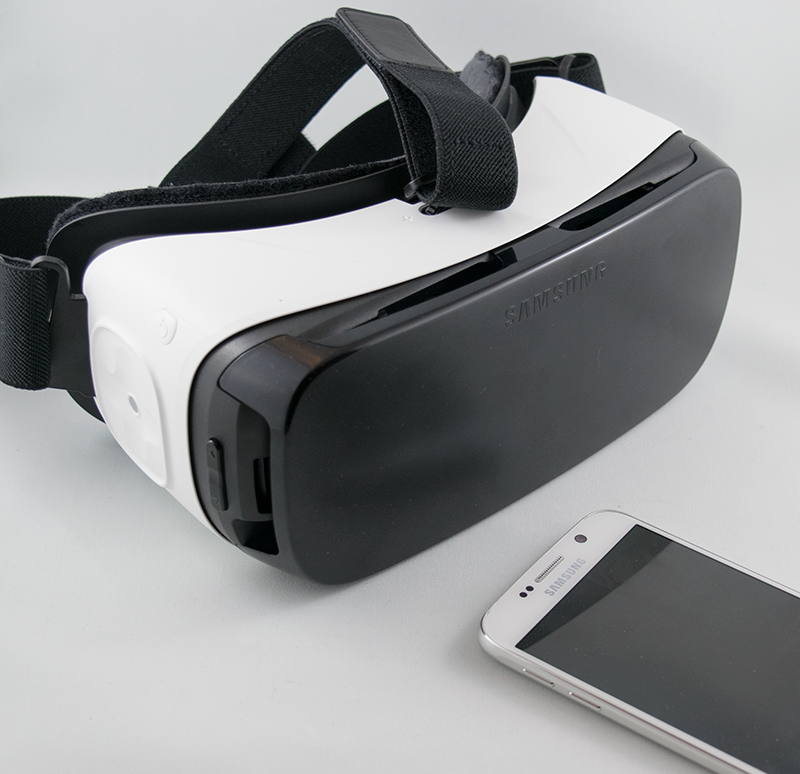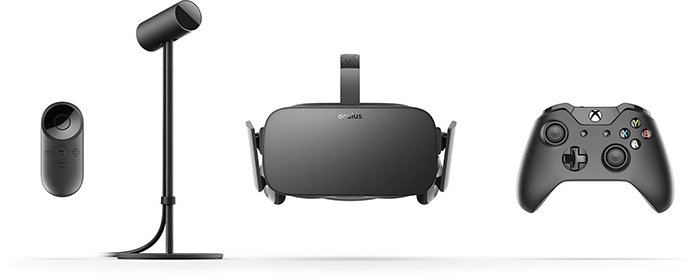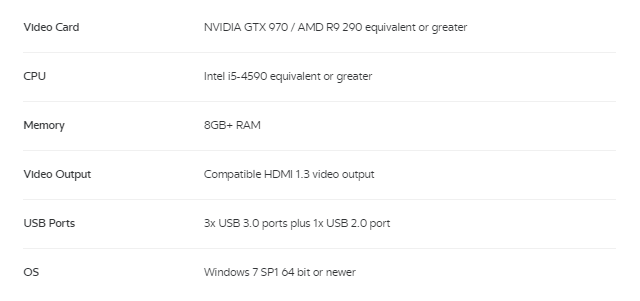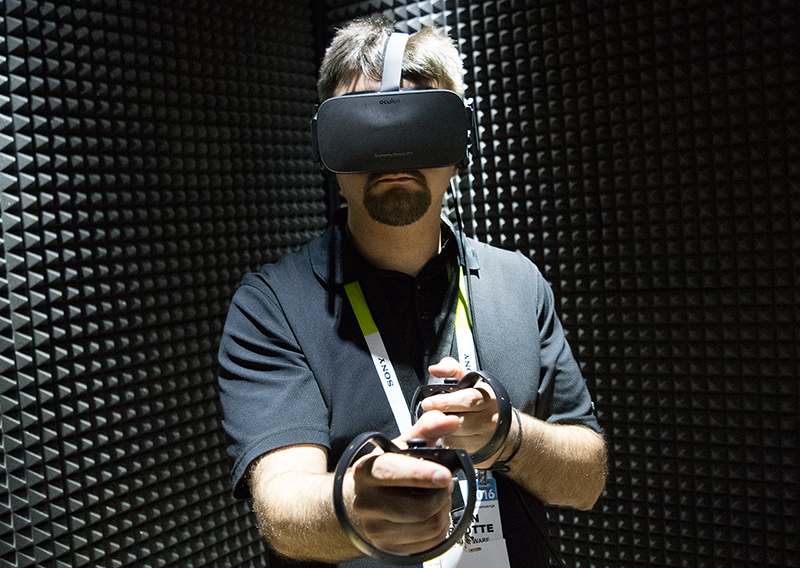On Thursday, I was a guest on the Level 1 Scrubs podcast. I was brought on the show to talk about virtual reality, and the experiences I’ve been fortunate enough to have with the various headsets that are coming out. Near the end of the show, I was asked which headset people should buy, and I quickly replied “Vive, if you can afford it” (it won’t be cheap), but that’s not really true. The right VR setup will be different for different people. Let me explain.
What you should buy depends a lot on you: what you intend to do within VR, what you can afford, and how much space you have for the system. Each VR experience that is available, or will be in the near future, is inherently different, and though they all fit within the VR blanket, the experience they provide will range tremendously.
The most basic and readily-available VR setup is Google’s Cardboard, which is literally made of cardboard (some third party Cardboard devices are plastic). These devices have two cheap lenses in them and you can fit your cell phone into it to watch stereoscopic 3D videos, 360-degree videos or panoramic images, and play some rudimentary games. This setup is very cheap though. You can sometimes get cardboard viewers free, but you can purchase one for around $20 USD.
Google has built an ecosystem of available apps and experiences that are Cardboard certified, and the access these applications properly you need a Cardboard device. The main key for certification is that the headset cannot have a strap. Google’s view is that you are far less susceptible to motion sickness if you have your hands holding the screen, so it doesn’t allow straps on Cardboard devices.
The next step up would be a head-mounted cell phone VR headset. There are dozens of them out there, and they can be purchased for anywhere from $50 to a $150, but I wouldn’t invest in one of these just yet. These headsets are in a weird space where there’s no ecosystem providing direct support, so the content is very limited. You can mostly only watch stereoscopic and 360-degree video. There certainly are some games, but you will be limited, and there are better options for that kind of money.
Gear VR would be one of those better options. It is a $140 accessory that gives a high-quality VR experience on a smartphone. This is only viable if you have one of Samsung’s Galaxy phones from the current lineup, though — it’s only compatible with S6, S6 Edge, S6 Edge+ and Note 5 phones. (here is a version called the Gear VR Innovator Edition that does work with the S5 and Note 4, but those are no longer available.)
Gear VR was designed with Oculus’s help, and Oculus maintains the content distribution system for the platform. This is a phone-connected device, rather than an agnostic, passive case like the previous examples. When you plug the phone in the Oculus Gear VR home automatically opens up for you because it connects through USB.
Because the Gear VR is backed by Oculus, it has fostered a lot of support from VR develpers. There are dozens, if not hundreds of games and experiences for the platform. It has Netflix support if you feel like watching a movie on a big screen TV in a virtual room, and Jaunt has an app so you can watch all kinds of things filmed with 360-degree cameras. Of course, you’ll also find games of all kinds.
The Gear VR is currently the best you can get for smartphone-based VR, which enables it to be very portable, and tether-free, but it is limited in scope because of the power of smartphones. PCs are far and away more capable of handling virtual reality, so for the premium experience, that’s what you need.
Later this year, we will see at least three top-tier VR headsets hit the market. First up is Oculus with the retail version of the highly anticipated Rift. This device has been years in the making, and people were starting to give up hope that it was coming out. Even when it did, many were disillusioned by the price of the hardware ($599 USD — with the current exchange rate, that’s $849 CDN), but it’s finally coming, and those that weren’t worried about cost bought it up in droves. The first Rift customers will start to receive their headsets at the end of March, but pre-orders are backed up all the way to July right now, so there’s no shortage of buyers.
The Rift offers a high level experience in VR. You get two high quality OLED displays with a combined resolution of 2160×1200, which doesn’t sound like much, but does the job very nicely. The build quality of the hardware is a significant bump up from what you might have tried with a DK2.
The thing about the Rift is that the experiences you can have with it will be limited to seated and standing. The hardware has the capability to do room-scale movement, but Oculus has not been pushing that very hard, and the initial launch will only have one tracker and use an Xbox One controller for gameplay. Touch, the company’s hand controllers, will come later in the year — things will change, but Touch will add more cost to the setup.
Shortly after the Rift hits the market, HTC’s Vive will be available to the public as well. The Vive pre-orders start on February 29, and the company said it intends to ship to customers in April. This system doesn’t have a price yet, but I’m not expecting it to be cheap. Most people that have tried it, or work with it (developers) believe that it will be priced higher than the Rift (for good reason) and believe that it could be even twice as much.
The higher cost assumptions are due to what comes with it, and what it can do. HTC’s Vive offers a whole other level of VR immersion. The Vive includes two hand controllers that operate like Wii-motes. They are wands that are tracked in 3D space and let you track your hands within the game. In addition, the setup includes a system that can track your physical movement within 3D space called Lighthouse.
You have to set up laser emitters on two opposing sides of your room. The headset and controllers have sensors all over them that sense the laser beams and calculate your whereabouts and position. The result is the ability to walk around within the game that you are playing. This of course requires space to do within your home, so it will require either some reconfiguration or some planning.
Vive lets you walk around in up to 15 x 15 feet of space, but it can be scaled down to as little as 5 x 6.5 feet. You can also play seated games with the system, but its real charm is with walking around. It gives you full immersion within the environment. The tradeoff is you have to be mindful of the very long cable tethering you to your computer.
Each of these setups will be costly, but they will cost you even more if you don’t already have the computer for it. The vast majority of people don’t have PC’s ready to play VR games. HTC hasn’t detailed the specs yet, but it should be very similar to what Oculus is calling for to play with the Rift.
You need an i5 processor, 8GBs of memory and a few USB 3.0 ports. That’s the easy part. On the graphics side you need at least a GTX 970, or an R9 290. These aren’t exactly budget cards. In fact, Nvidia estimates less than 13 million PCs have VR-ready Nvidia cards and AMD said a little more than 5 million VR ready AMD cards are out there. It’s going to take some time before most people are able to afford to buy into PC connected VR.
There’s still an option for you, though. Playstation VR will be launching in the first half of this year and it will connect directly to the Playstation 4 console. Sony recently said there are 36 million PS4s out there, so the potential install base is much greater. Sony has a big lineup of games coming for PSVR too. The company said there are over 200 developers working on projects, so there’s plenty of content coming for the platform.
 The PSVR includes two tracked PS Move controllers, the PS Camera to track them, and the headset which is also tracked by the camera. The system doesn’t offer room scale — in fact, Sony has told developers to target seated experiences — but it does offer hand tracking, and a social aspect where other players can play along with the TV and standard controller while someone plays in VR.
The PSVR includes two tracked PS Move controllers, the PS Camera to track them, and the headset which is also tracked by the camera. The system doesn’t offer room scale — in fact, Sony has told developers to target seated experiences — but it does offer hand tracking, and a social aspect where other players can play along with the TV and standard controller while someone plays in VR.
So, as you can see, there are vast differences between each of the VR systems coming out in the near future.
Which one should you save your pennies for? If I’m honest, I have to say all of them. If you can afford to have them all, get them all — they will each offer their own pros and their own cons, and will suit different needs. If you can’t afford to buy them all (like most of us mere mortals), then think about what interests you most about VR, and buy the platform that best satiates that desire.
Though, I would suggest trying them out before you invest.
Kevin Carbotte is Senior Editor, Hardware for AYBOnline.com. He knows a little about a lot, and a lot about a little. The opinions in his columns are his and his alone, but you are free to have them.


